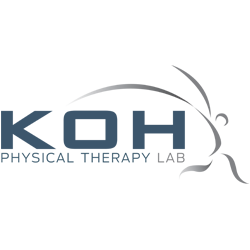Davis Koh MS PT ’96, DPT ’99, MBA ’07 helps competitive weightlifters deal with the inevitable aches and pains that come from doing seemingly superhuman tasks.
BY BREANNE GRADY MCM ’10
inMotion Fall 2015
Davis Koh believes very strongly in helping others. This passion was born in Koh during his undergraduate years at UCLA and has only grown stronger in his nearly two decades-long career as a physical therapist.
“I realized by senior year that I had narrowed down things about myself,” he says reflectively. “I knew I wanted to help people, and help them medically, but also to help them through a process and to help as many different areas of the body and as many different injuries.”
His desire to serve others extends to his work with many professional athletes, including a number of Team USA Olympic athletes. He has been working as part of the medical team for a variety of Olympic events — weightlifting, volleyball, bobsled and skeleton, gymnastics and sailing — since the Beijing games in 2008
“You do feel like you’re helping your country,” he says of the work. “There is a sense of national pride when we wear the USA medical team clothing, a sense of representation and responsibility when we go out.”
Koh first started working with Team USA Weightlifting in 2008 at the Olympic Training Center in Colorado Springs, Colo. Soon thereafter, the United States Olympic Committee invited Koh to be a part of their medical team, where he’s been serving ever since. Since being assigned to the medical team, he has been invited to work at various national and international weightlifting championships.
Later this fall, Koh will be part of the medical team for the International Weightlifting Federation World Weightlifting Championships, taking place Nov. 20–28 in Houston. The competition is a qualifying event for American athletes to represent Team USA Weightlifting in Rio De Janeiro 2016.
“In a typical day, there are some medical practitioners out on the floor to watch over the athletes who are actually in competition,” he says. “There will be other athletes in the back coming in prior to the event needing to get some work done such as magnotherapy, some taping, some stretching an hour or two before their lift.”
If an athlete remains in competition, Koh will often perform post-treatments after their lifts. “It’s manual treatment,” he explains. “You might be working out rotator cuff strain or on knee pain or something in the lower back to get them as ready as possible with taping, manual techniques or soft tissue mobilizations.”
In general, Koh says his job is to help the athletes simply get through the event, to help treat them enough to get them on the floor or advise them not to compete. “If they get enough points, they get to go to Rio next year,” he says. “So they will do anything they can to make sure they get through the event.” If an athlete is injured during competition, Koh and the other practitioners will determine the best form of care. “They’ll get more in-depth treatment to repair any lingering issues from that event or things they’ve been dealing with from the past that they are just trying to get healed up as much as possible before the next event,” he says.
Koh notes that the benefits of competitive weightlifting, if done properly, can outweigh the risks. He explains that weightlifters have tremendous cardiac strength.
“The reason for that is when they are lifting heavy weight, hundreds and hundreds of pounds, over their head, there is an amount of force and muscle tension required to do that,” he explains. “The heart has to push past that resistance to get the blood flowing through.” Despite the cardiac benefits, Koh recognizes that aspects of the sport can be very taxing on the body and even result in serious injuries.
“There’s no room for margin of error because the weight is so heavy that it can easily snap an elbow, tear through a side or cause knee problems,” he says. “It’s either a very easy day or a tragic day when they’re almost there and they are trying to maintain their form and their elbow snaps off.”
Without a doubt, Koh believes his work with Team USA Weightlifting is incredibly rewarding.
“A lot of the weightlifters are just very hardworking, down-to-earth people that work just as hard as other athletes in other sports who are getting paid millions of dollars,” he explains.
Despite his high-profile Olympic involvement, Koh’s clinical practice in Orange County, helps him stay well-rounded with a variety of cases. “There is still the 86-year-old stroke patient coming in, the NBA player leaving, the 16-year-old Junior Olympic soccer player coming in and the 47-year-old knee replacement patient going out,” he says.
Koh believes his education at the USC Division of Biokinesiology and Physical Therapy provided state-of-the-art training and connections that have served him throughout his career.
“USC created a very strong foundation with manual skills, with the latest research and with professors who are respected nationally and internationally, so you know you’re getting the latest research and the latest techniques that a new physical therapist can absorb,” he says.
He has a sense of pride for the USC brand — he currently serves as president of the USC Physical Therapy Alumni Association — and emphasizes the alumni connections and the sense of family that comes into play for Trojan physical therapists.
“You can’t quantify it in money, but you can quantify it in terms of opportunities,” he says. “The guidance I’ve received from other alumni has been invaluable, and you have a confidence in knowing you have them as your own personal direct line.”
inMotion the Official Publication of USC Division of Biokinesiology and Physical Therapy

